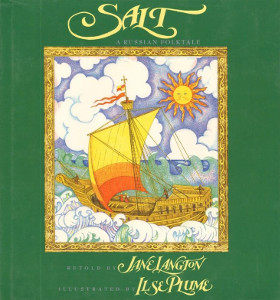Salt: A Russian Folktale (Adaptation)

Illustrator:
Ilse Plume
Jane Langton
Original author:
Aleksandr Afanasev
Original language:
Russian
Translator:
Alice Plume
Publication:
1992 by Hyperion Books for Children
Genre:
Fairy Tales, Fiction, Folk Tales, Picture Books
Pages:
48
Current state:
Basic information has been added for this book.
It has been read and any content considerations have been added.
Book Guide
Search for this book used on:
From a small Russian village, three brothers are sent into the world by their father to find their fortunes. Fyodor is sent to the far north in the largest ship with furs of wolf and fox and sable; Vasily is sent to the cities of the south in a fine ship with a cargo of gleaming ice; and Ivan, thought of as a fool by his father, is sent out in a small ship filled only with wooden spoons.
Fyodor and Vasily set sail with hopes of discovering vast wealth and claiming it as their own. But Ivan, the dreamer, leaves his home port asking, "How high is the sky?" and "Is the world round or flat?" Fyodor and Vasily meet only doom and disaster from their travels. But Ivan discovers a mountain made of salt—the spice of life—which he trades to a foreign tsar for barrels of gold, silver, and precious gems.
After a storm ravages Fyodor's and Vasily's ships, Ivan rescues his two older brothers and offers to share his bounty with them. But their greed leads to treachery; they claim Ivan's successes as their own and throw him overboard. Ivan, however, is not to be beaten so easily. Spurred on to complete his journey by his love for a beautiful tsarevna whom his brothers have taken as their own, he will not be stopped by any challenge—no matter how large.
Newbery Honor winner Jane Langston's prose is rich in the cadences of traditional Russian storytelling, and Caldecott Honor winner Ilse Plume's jewellike paintings re-create the classic symbols of the Russian heritage in exquisite detail.
Children will delight in the story of Ivan's bravery, generosity, and finally in his discovery of how high the sky is and whether the world is round or flat.
From the dust jacket
To view an example page please sign in.
Resource Guide
Episode 70: Why Read Fairy Tales?
Released in 2020 by The Literary Life
Available formats: Streaming Audio
Length: 1 hr. 29 min.
View on the The Literary Life site
"Angelina Stanford and Cindy Rollins tackle the topic of fairy stories, discussing the what, why and how of reading them. Angelina shares the distinctive characteristics of fairy stories in contrast to other types of stories, such as myths. They deal with the question of whether fairy tales are 'escapist', the influence of the Grimm brothers scholarly work on interpreting fairy stories, and allowing the story to unveil its deeper truths without forcing meaning onto it.
Angelina gives an illustration of how to see the gospel messages in fairy tales by talking us through the story of Sleeping Beauty. She refutes the ideas that fairy tales are about human romance or are misogynistic. She also highlights some of the Enlightenment and Puritan responses to fairy tales that still linger with us today. Cindy and Angelina also discuss some common concerns such as the magical, weird, or scary aspects of fairy tales. Angelina also makes a distinction between folk tales, literary fairy tales, and cautionary tales."
Find This Book
Search for this book used on:





